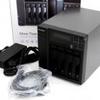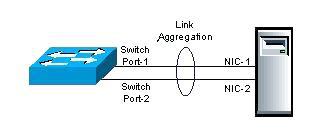NAS Explained
Asustor AS6404T
The Asustor AS6404T can house four hard drives or SSDs. This NAS unit is tied to two Gigabit Ethernet jacks, meaning 1000 / 8 minus QOS and random overhead like error-correction is roughly a maximum of 100 to 125 MB/sec on a single Gigabit Ethernet connection. The tested AS6404T can house four storage units, these can be set up in Single, JBOD, RAID 0/1/5. Once you have installed your hardware, you'll need to bind the NAS to your Ethernet with a CAT5e/6e cable to a switch; the Asustor NAS offers more connectors though including USB 3.0. When you have your HDDs installed, and the device connected through your PC you'll need to start-up a software suite to bind and set up your configuration. Please look at the install CD for that. Or if you have a smartphone, simply use a smartphone app like FING and scan the network, Asustor will show up with a corresponding IP. Type the IP into your browser and you can start setting up the unit.
- CPU: Intel Celeron J3455 Quad-Core 1.5 GHz (boost up-to 2.3GHz) Processor
- Memory: 8GB SO-DIMM DDR3L (4GB x2, Expandable. Max 8GB)
- HDD: 4 x SATA3 6Gb/s; 3.5"/2.5" HDD/SSD Compatibility
- Maximum Internal Raw Capacity: 40 TB (10 TB HDD X 4, capacity may vary by RAID types)
- Expansion: USB 3.0 x 4 (Type A x3, Type C x1)
- Network: Gigabit Ethernet x 2
- LCD Panel
- Output: HDMI 2.0 x 1, S/PDIF x1
- System Fan: 120mm x 1
- Infrared Receiver
- Audio Output: S/PDIF
- Power Supply Unit / Adapter: 90W x1
- Input Power Voltage: 100V to 240V AC
An Apollo Lake Celly in her Belly
- Video decode hardware acceleration including support for HEVC (H.265), H.264, MVC, VP8, VP9, MPEG2, VC-1, WMV9, JPEG/MJPEG.
- Video encode hardware acceleration including support for HEVC (H.265), H.264, MVC, VP8, VP9, JPEG/MJPEG.
- Power Consumption: 24 W (Operation);
- 11.2 W (Disk Hibernation);
- 0.44 W (Sleep Mode)
You network topology needs to match though:
- Your switches need to support Link aggregation (layer2)
- Your NAS needs to support Link aggregation (this one obviously does)
- You need multiple Gigabit controllers in your PC or use multiple PCs
- You need fast enough storage units
- You'll need multiple network links for and to your switch.
| File Storage Capacity by Bits and Bytes | ||||
| Byte | Kilobyte | Megabyte | Gigabyte | |
| Kilobyte | 1,024 | 1 | 1,024 | 1,048,576 |
| Megabyte | 1,048,576 | 1,024 | 1 | 1,024 |
| Gigabyte | 1,073,741,824 | 1,048,576 | 1,024 | 1 |
| Terabyte | 1,099,511,627,776 | 1,073,741,824 | 1,048,576 | 1,024 |
| Petabyte | 1,125,899,906,842,620 | 1,099,511,627,776 | 1,073,741,824 | 1,048,576 |
| Exabyte | 1,152,921,504,606,850,000 | 1,125,899,906,842,620 | 1,099,511,627,776 | 1,073,741,824 |
| Zettabyte | 1,180,591,620,717,410,000,000 | 1,152,921,504,606,850,000 | 1,125,899,906,842,620 | 1,099,511,627,776 |
So we passed the Terabyte marker. With our hefty demand in storage capabilities, the industry had to constantly adapt and introduce new features in hardware. Storage units got much bigger in volume over the year, 6 TB HDDs have just been introduced onto the market with 10 TB already in the pipeline. In that line of storage solutions there is one product series growing fast and now reaching SOHO and consumer based markets. They are called NAS units, Network Attached Storage. And there has been a lot of development in these nifty little boxes. Pretty much they are little servers that can hook onto your network and then function as file-servers.
The NAS units are often small, do not use a lot of power compared to, say, your PC, but they are highly configurable, offer redundancy as some models can even handle RAID internally. Network Attachable Storage units are among the most advanced home servers available on the market today. Products feature multiple HDD setups, partitions, RAID, USER and USERGROUP based access, FTP, web server, MySQL, hot swappable drives; these are just some of the features that a NAS unit can handle. And though expensive, a product like this is just too darn handy when it comes to file-storage and management over your network.


